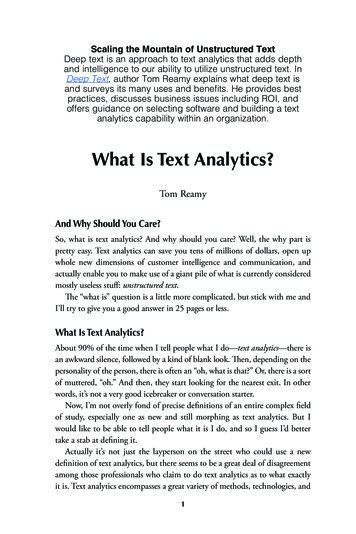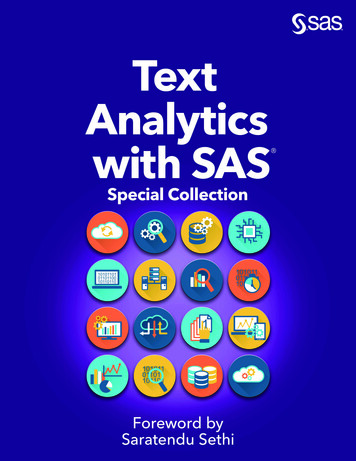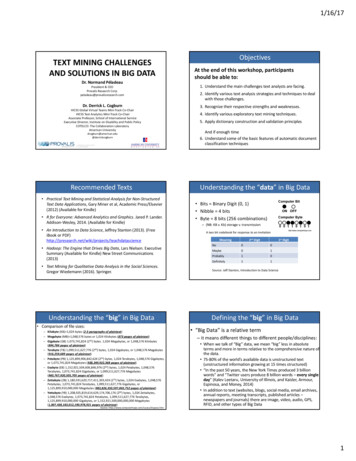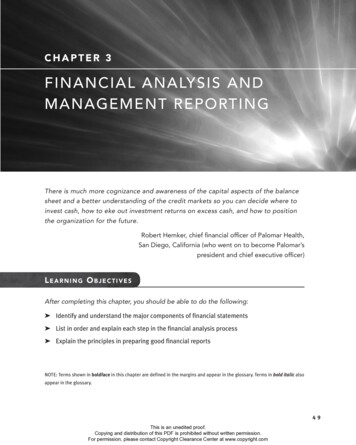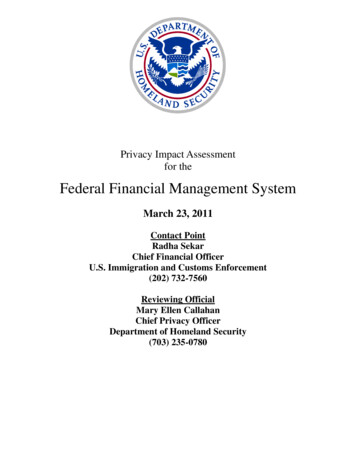
Transcription
PublishingF9 Study TextFinancial ManagementACCA
ACCAPaperF9Financial managementWelcome to Emile Woolf‘s study text forPaper F9 Financial management which is: Written by tutors Comprehensive but concise In simple English Used around the world by Emile Woolf Collegesincluding China, Russia and the UKPublishing
Third edition published byEmile Woolf Publishing LimitedCrowthorne Enterprise Centre, Crowthorne Business Estate, Old Wokingham Road,Crowthorne, Berkshire RG45 6AWEmail: info@ewiglobal.comwww.emilewoolfpublishing.com Emile Woolf Publishing Limited, April 2011All rights reserved. No part of this publication may be reproduced, stored in a retrievalsystem, or transmitted, in any form or by any means, electronic, mechanical, photocopying,recording, scanning or otherwise, without the prior permission in writing of Emile WoolfPublishing Limited, or as expressly permitted by law, or under the terms agreed with theappropriate reprographics rights organisation.You must not circulate this book in any other binding or cover and you must imposethe same condition on any acquirer.NoticeEmile Woolf Publishing Limited has made every effort to ensure that at the time ofwriting the contents of this study text are accurate, but neither Emile Woolf PublishingLimited nor its directors or employees shall be under any liability whatsoever for anyinaccurate or misleading information this work could contain.British Library Cataloguing in Publications DataA catalogue record for this book is available from the British Library.ISBN: 978‐1‐84843‐147‐8Printed and bound in Great BritainAcknowledgementsThe syllabus and study guide are reproduced by kind permission of the Association ofChartered Certified Accountants.ii Emile Woolf Publishing Limited
Paper F9Financial managementCContentsPageSyllabus and study guide1Chapter 1:The financial management function13Chapter 2:The financial management environment37Chapter 3:Working capital management55Chapter 4:Management of working capital: inventory control77Chapter 5:Management of receivables and payables95Chapter 6:Cash management115Chapter 7:Introduction to investment appraisal and capital investmentdecisions137Chapter 8:Discounted cash flow153Chapter 9:DCF: taxation and inflation179Chapter 10: DCF: risk and uncertainty193Chapter 11: Capital investment appraisal: further aspects207Chapter 12: Sources of equity finance221Chapter 13: Sources of finance: debt capital245Chapter 14: Capital structure257Chapter 15: Finance for small and medium sized entities (SMEs)265Chapter 16: Cost of capital275Chapter 17: Capital asset pricing model (CAPM)303Chapter 18: Business valuations325Chapter 19: Foreign exchange risk357 Emile Woolf Publishing Limitediii
Paper F9: Financial managementPageivChapter 20: Interest rate risk397Answers to exercises433Practice questions443Answers475Appendix523Index527 Emile Woolf Publishing Limited
Paper F9Financial managementSSyllabus and study guideAimTo develop the knowledge and skills expected of a financial manager, relating toissues affecting investment, financing, and dividend policy decisions.Main capabilities After completing this examination paper students should be able to:ADiscuss the role and purpose of the financial management functionBAssess and discuss the impact of the economic environment on financialmanagementCDiscuss and apply working capital management techniquesDCarry out effective investment appraisalEIdentify and evaluate alternative sources of business financeFExplain and calculate cost of capital and the factors which affect itGDiscuss and apply principles of business and asset valuationsHExplain and apply risk management techniques in businessRationaleThe syllabus for Paper F9, Financial Management, is designed to equip candidateswith the skills that would be expected from a finance manager responsible for thefinance function of a business. The paper, therefore, starts by introducing the roleand purpose of the financial management function within a business. Before lookingat the three key financial management decisions of investing, financing, anddividend policy, the syllabus explores the economic environment in which suchdecisions are made. Emile Woolf Publishing Limited1
Paper F9: Financial managementThe next section of the syllabus is the introduction of investing decisions. This isdone in two stages – investment in (and the management of) working capital andthe appraisal of long-term investments.The next area introduced is financing decisions. This section of the syllabus starts byexamining the various sources of business finance, including dividend policy andhow much finance can be raised from within the business. Cost of capital and otherfactors that influence the choice of the type of capital a business will raise thenfollows. The principles underlying the valuation of business and financial assets,including the impact of costs of capital on the value of business is covered next.The syllabus finishes with an introduction to, and examination of, risk and the maintechniques employed in the management of such risk.Relational diagram of main syllabus capabilitiesFinancial managementfunction (A)Financial management environment (B)Working capitalmanagement (C)Investment appraisaltechniques (D)Sources of businessfinance (E)Cost of Capital (F)Business valuations (G)Risk management (H)2 Emile Woolf Publishing Limited
Syllabus and study guideDetailed syllabusAFinancial management function1.2.3.4.BFinancial management environment1.2.C3.The nature of investment decisions and the appraisal processNon-discounted cash flow techniquesDiscounted cash flow (DCF) techniquesAllowing for inflation and taxation in DCFAdjusting for risk and uncertainty in investment appraisalSpecific investment decisions (lease or buy; asset replacement, capitalrationing)Business finance1.2.3.4.5.6.FThe nature, elements and importance of working capitalManagement of inventories, accounts receivable, accounts payable andcashDetermining working capital needs and funding strategiesInvestment appraisal1.2.3.4.5.6.EThe economic environment for businessThe nature and role of financial markets and institutionsWorking capital management1.2.DThe nature and purpose of financial managementFinancial objectives and relationship with corporate strategyStakeholders and impact on corporate objectivesFinancial and other objectives in not-for-profit organisationsSources of,and raising short-term financeSources of,and raising long-term financeRaising short and long term finance through Islamic financingInternal sources of finance and dividend policyGearing and capital structure considerationsFinance for Small and Medium-size Entities (SMEs)Cost of capital1.2.Sources of finance and their relative costsEstimating the cost of equity3.4.5.6.Estimating the cost of debt and other capital instrumentsEstimating the overall cost of capitalCapital structure theories and practical considerationsImpact of cost of capital on investments5 GBusiness valuations1.2.Nature and purpose of the valuation of business and financial assetsModels for the valuation of shares Emile Woolf Publishing Limited3
Paper F9: Financial management3.4.HThe valuation of debt and other financial assetsEfficient market hypothesis (EMH) and practical considerations in thevaluation of sharesRisk management1.2.3.4.The nature and types of risk and approaches to risk managementCauses of exchange rate differences and interest rate fluctuationsHedging techniques for foreign currency riskHedging techniques for interest rate riskApproach to examining the syllabusThe syllabus for Paper F9 aims to develop the skills expected of a finance managerwho is responsible for the finance function of a business.The paper also prepares candidates for more advanced and specialist study in PaperP4, Advanced Financial Management.Examination structureThe syllabus is assessed by a three-hour paper-based examination consisting of fourcompulsory 25-mark questions. All questions will have computational anddiscursive elements. The balance between computational and discursive contentwill continue in line with the pilot paper.Candidates are provided with a formulae sheet and tables of discount and annuityfactors.Study guideThis study guide provides more detailed guidance on the syllabus. You should usethis as the basis of your studies.AFinancial management function1The nature and purpose of financial managementa)b)2Financial objectives and the relationship with corporate strategya)b)4Explain the nature and purpose of financial management.Explain the relationship between financial management andfinancial and management accounting.Discuss the relationship between financial objectives, corporateobjectives and corporate strategy.Identify and describe a variety of financial objectives, including:i)shareholder wealth maximisationii)profit maximisationiii) earnings per share growth Emile Woolf Publishing Limited
Syllabus and study guide3Stakeholders and impact on corporate objectivesa)b)c)d)e)4Financial and other objectives in not-for-profit organisationsa)b)c)BIdentify the range of stakeholders and their objectivesDiscuss the possible conflict between stakeholder objectivesDiscuss the role of management in meeting stakeholder objectives,including the application of agency theory.Describe and apply ways of measuring achievement of corporateobjectives including:i)ratio analysis, using appropriate ratios such as return oncapital employed, return on equity, earnings per share anddividend per shareii)changes in dividends and share prices as part of totalshareholder returnExplain ways to encourage the achievement of stakeholderobjectives, including:i)managerial reward schemes such as share options andperformance-related payii)regulatory requirements such as corporate governance codesof best practice and stock exchange listing regulationsDiscuss the impact of not-for-profit status on financial and otherobjectives.Discuss the nature and importance of Value for Money as anobjective in not-for-profit organisations.Discuss ways of measuring the achievement of objectives in notfor-profit organisations.Financial management environment1The economic environment for businessa)b)c)d)2Identify and explain the main macroeconomic policy targets.Define and discuss the role of fiscal, monetary, interest rate andexchange rate policies in achieving macroeconomic policy targets.Explain how government economic policy interacts with planningand decision-making in business.Explain the need for, and the interaction with, planning anddecision-making in business of:i)competition policyii)government assistance for businessiii) green policiesiv) corporate governance regulation.The nature and role of financial markets and institutionsa)b)c)d) Emile Woolf Publishing LimitedIdentify the nature and role of money and capital markets, bothnationally and internationally.Explain the role of financial intermediaries.Explain the functions of a stock market and a corporate bondmarket.Explain the nature and features of different securities in relation tothe risk/return trade-off.5
Paper F9: Financial managementCWorking capital management1The nature, elements and importance of working capitala)b)c)2.Management of inventories, accounts receivable, accounts payableand casha)b)c)d)e)f)3Explain the cash operating cycle and the role of accounts payableand accounts receivable.Explain and apply relevant accounting ratios, including:i)current ratio and quick ratioii)inventory turnover ratio, average collection period andaverage payable periodiii) sales revenue/net working capital ratioDiscuss, apply and evaluate the use of relevant techniques inmanaging inventory, including the Economic Order Quantitymodel and Just-in-Time techniques.Discuss, apply and evaluate the use of relevant techniques inmanaging accounts receivable, including:i)assessing creditworthinessii)managing accounts receivableiii) collecting amounts owingiv) offering early settlement discountsv)using factoring and invoice discountingvi) managing foreign accounts receivableDiscuss and apply the use of relevant techniques in managingaccounts payable, including:i)using trade credit effectivelyii)evaluating the benefits of discounts for early settlement andbulk purchaseiii) managing foreign accounts payableExplain the various reasons for holding cash, and discuss andapply the use of relevant techniques in managing cash, including:i)preparing cash flow forecasts to determine future cash flowsand cash balancesii)assessing the benefits of centralised treasury managementand cash controliii) cash management models, such as the Baumol model andthe Miller-Orr modeliv) investing short-termDetermining working capital needs and funding strategiesa)6Describe the nature of working capital and identify its elements.Identify the objectives of working capital management in terms ofliquidity and profitability, and discuss the conflict between them.Discuss the central role of working capital management infinancial management.Calculate the level of working capital investment in current assetsand discuss the key factors determining this level, including:i)the length of the working capital cycle and terms of trade Emile Woolf Publishing Limited
Syllabus and study guideii)b)Dan organisation’s policy on the level of investment in currentassetsiii) the industry in which the organisation operatesDescribe and discuss the key factors in determining workingcapital funding strategies, including:i)the distinction between permanent and fluctuating currentassetsii)the relative cost and risk of short-term and long-term financeiii) the matching principleiv) the relative costs and benefits of aggressive, conservativeand matching funding policiesv)management attitudes to risk, previous funding decisionsand organisation sizeInvestment appraisal1The nature of investment decisions and the appraisal processa)b)c)2Non-discounted cash flow techniquesa)b)c)3Distinguish between capital and revenue expenditure, andbetween non-current assets and working capital investment.Explain the role of investment appraisal in the capital budgetingprocess.Discuss the stages of the capital budgeting process in relation tocorporate strategy.Identify and calculate relevant cash flows for investment projects.Calculate payback period and discuss the usefulness of payback asan investment appraisal method.Calculate return on capital employed (accounting rate of return)and discuss its usefulness as an investment appraisal method.Discounted cash flow (DCF) techniquesa)b)c)d)e) Emile Woolf Publishing LimitedExplain and apply concepts relating to interest and discounting,including:i)the relationship between interest rates and inflation, andbetween real and nominal interest ratesii)the calculation of future values and the application of theannuity formulaiii) the calculation of present values, including the present valueof an annuity and perpetuity, and the use of discount andannuity tablesiv) the time value of money and the role of cost of capital inappraising investmentsCalculate net present value and discuss its usefulness as aninvestment appraisal method.Calculate internal rate of return and discuss its usefulness as aninvestment appraisal method.Discuss the superiority of DCF methods over non-DCF methods.Discuss the relative merits of NPV and IRR.7
Paper F9: Financial management4Allowing for inflation and taxation in DCFa)b)c)5Adjusting for risk and uncertainty in investment appraisala)b)c)d)6.Apply and discuss the real-terms and nominal-terms approachesto investment appraisal.Calculate the taxation effects of relevant cash flows, including thetax benefits of capital allowances and the tax liabilities of taxableprofit.Calculate and apply before- and after-tax discount rates.Describe and discuss the difference between risk and uncertaintyin relation to probabilities and increasing project life.Apply sensitivity analysis to investment projects and discuss theusefulness of sensitivity analysis in assisting investment decisions.Apply probability analysis to investment projects and discuss theusefulness of probability analysis in assisting investmentdecisions.Apply and discuss other techniques of adjusting for risk anduncertainty in investment appraisal, including:i)simulationii)adjusted paybackiii) risk-adjusted discount ratesSpecific investment decisions (Lease or buy; asset replacement;capital rationing)a)b)c)Evaluate leasing and borrowing to buy using the before-and aftertax costs of debt.Evaluate asset replacement decisions using equivalent annual cost.Evaluate investment decisions under single-period capitalrationing, including:i)the calculation of profitability indexes for divisibleinvestment projectsii)the calculation of the NPV of combinations of non-divisibleinvestment projectsiii) a discussion of the reasons for capital rationing9EBusiness finance1Sources of and raising short-term financea) I2Sources of and raising, long-term financea)8dentify and discuss the range of short-term sources of financeavailable to businesses, including:i)overdraftii)short-term loaniii) trade creditiv) lease financeIdentify and discuss the range of long-term sources of financeavailable to businesses, including:i)equity finance Emile Woolf Publishing Limited
Syllabus and study guideb)3Raising short and long term finance through Islamic financinga)b)c)4b)c)Identify and discuss internal sources of finance, including:i)retained earningsii)increasing working capital management efficiencyExplain the relationship between dividend policy and thefinancing decisionDiscuss the theoretical approaches to, and the practical influenceson, the dividend decision, including:i)legal constraintsii)liquidityiii) shareholder expectationsiv) alternatives to cash dividendsGearing and capital structure considerationsa)b)6Explain the major difference between Islamic finance and the otherconventional finance.Explain the concept of interest (riba) and how returns are made byIslamic financial securities. (calculations are not required)Identify and briefly discuss a range of short and long term Islamicfinancial instruments available to businesses includingi)trade credit (murabaha)ii)lease finance (ijara)iii) equity finance (mudaraba)iv) debt finance (sukuk)v)venture capital (musharaka)Internal sources of finance and dividend policya)5ii)debt financeiii) lease financeiv) venture capitalIdentify and discuss methods of raising equity finance, including:i)rights issueii)placingiii) public offeriv) stock exchange listingIdentify and discuss the problem of high levels of gearingAssess the impact of sources of finance on financial position andfinancial risk using appropriate measures, including:i)ratio analysis using statement of financial position gearing,operational and financial gearing, interest coverage ratio andother relevant ratiosii)cash flow forecastingiii) effect on shareholder wealthFinance for small and medium sized entities (SMEs)a) Emile Woolf Publishing LimitedDescribe the financing needs of small businesses.9
Paper F9: Financial managementb)c)d)Describe the nature of the financing problem for small businessesin terms of the funding gap, the maturity gap and inadequatesecurity.Explain measures that may be taken to ease the financingproblems of SMEs, including the responses of governmentdepartments and financial institutions.Identify appropriate sources of finance for SMEs and evaluate thefinancial impact of different sources of finance on SMEs.10FCost of capital1Sources of finance and their relative costsa)b)2Estimating the cost of equitya)b)c)3Distinguish between average and marginal cost of capital.Calculate the weighted average cost of capital (WACC) using bookvalue and market value weightings.Capital structure theories and practical considerationsa)b)c)d)10Calculate the cost of capital of a range of capital instruments,including:i)irredeemable debtii)redeemable debtiii) convertible debtiv) preference sharesv)bank debtEstimating the overall cost of capitala)b)5Apply the dividend growth model and discuss its weaknesses.Apply the capital asset pricing model (CAPM) and describe andexplain the assumptions and components of the CAPM.Explain and discuss the advantages and disadvantages of theCAPM.Estimating the cost of debt and other capital instrumentsa)4Describe the relative risk-return relationship and the relative costsof equity and debt.Describe the creditor hierarchy and its connection with the relativecosts of sources of finance.Describe the traditional view of capital structure and itsassumptions.Describe the views of Miller and Modigliani on capital structure,both without and with corporate taxation, and their assumptions.Identify a range of capital market imperfections and describe theirimpact on the views of Miller and Modigliani on capital structure.Explain the relevance of pecking order theory to the selection ofsources of finance. Emile Woolf Publishing Limited
Syllabus and study guide6Impact of cost of capital on investmentsa)b)c)d)GExplain the relationship between company value and cost ofcapital.Discuss the circumstances under which WACC can be used ininvestment appraisal.Discuss the advantages of the CAPM over WACC in determininga project-specific cost of capital.Apply the CAPM in calculating a project-specific discount rate.Business valuations1Nature and purpose of the valuation of business and financialassetsa)b)2Models for the valuation of sharesa)b)c)3Asset-based valuation models, including:i)net book value (statement of financial position basis).ii)net realisable value basis.iii) net replacement cost basis.Income-based valuation models, including:i)price/earnings ratio method.ii)earnings yield method.Cash flow-based valuation models, including:i)dividend valuation model and the dividend growth model.ii)discounted cash flow basis.The valuation of debt and other financial assetsa)4Identify and discuss reasons for valuing businesses and financialassets.Identify information requirements for valuation and discuss thelimitations of different types of information.Apply appropriate valuation methods to:i)irredeemable debtii)redeemable debtiii) convertible debtiv) preference sharesEfficient Market Hypothesis (EMH) and practical considerations inthe valuation of sharesa)b)c) Emile Woolf Publishing LimitedDistinguish between and discuss weak form efficiency, semistrong form efficiency and strong form efficiencyDiscuss practical considerations in the valuation of shares andbusinesses, including:i)marketability and liquidity of sharesii)availability and sources of informationiii) market imperfections and pricing anomaliesiv) market capitalisationDescribe the significance of investor speculation and theexplanations of investor decisions offered by behavioural finance11
Paper F9: Financial managementHRISK MANAGEMENT1The nature and types of risk and approaches to risk managementa)b)2Causes of exchange rate differences and interest rate fluctuationsa)b)c)3Describe and discuss different types of foreign currency risk:i)translation riskii)transaction riskiii) economic riskDescribe and discuss different types of interest rate risk:i)gap exposureii)basis riskDescribe the causes of exchange rate fluctuations, including:i)balance of paymentsii)purchasing power parity theoryiii) interest rate parity theoryiv) four-way equivalenceForecast exchange rates using:i)purchasing power parityii)interest rate parityDescribe the causes of interest rate fluctuations, including:i)structure of interest rates and yield curvesii)expectations theoryiii) liquidity preference theoryiv) market segmentationHedging techniques for foreign currency riska)b)c)Discuss and apply traditional and basic methods of foreigncurrency risk management, including:i)currency of invoiceii)netting and matchingiii) leading and laggingiv) forward exchange contractsv)money market hedgingvi) asset and liability managementCompare and evaluate traditional methods of foreign currencyrisk management.Identify the main types of foreign currency derivates used tohedge foreign currency risk and explain how they are used inhedging.(No numerical questions will be set on this topic)4Hedging techniques for interest rate riska)b)12Discuss and apply traditional and basic methods of interest raterisk management, including:i)matching and smoothingii)asset and liability managementii)forward rate agreementsIdentify the main types of interest rate derivates used to hedgeinterest rate risk and explain how they are used in hedging.(No numerical questions will be set on this topic) Emile Woolf Publishing Limited
CHAPTERPaper F9Financial management1The financial managementfunctionContents Emile Woolf Publishing Limited1Financial management2Financial objectives3Stakeholders4Regulatory requirements5Not‐for‐profit organisations13
Paper F9: Financial managementFinancial management The nature of financial management Financial management, management accunting and financial accounting1Financial management1.1The nature of financial managementFinancial management is about planning and controlling the financial affairs of anorganisation, to ensure that the organisation achieves its objectives, particularly itsfinancial objectives. This involves decisions about:1.2 how much finance the business needs for its operations, both its day-to-dayoperations and for longer-term investment projects where the finance should be obtained from: long-term finance is raised as equitycapital (share capital and profits) or as debt capital, and short-term finance isobtained mainly from trade suppliers and bank overdrafts what should be the balance between long-term and short-term finance, and whatshould be the balance between equity capital and debt capital (in other words,what should be the capital structure of the organisation?) investing short term cash surpluses ensuring that the providers of finance are suitably rewarded: the organisationmust make sure that it can meet the interest payments on its borrowing, andcompanies must ensure that shareholders receive an appropriate dividend out ofprofits where appropriate, protecting the organisation against financial risks.Financial management, management accounting and financialaccountingFinancial management has a strong accounting element, and in large organisationsit is usual to find that professional accountants are involved in financial accounting,management accounting and financial management.Financial accounting is concerned primarily with maintaining a system of accounts(the ledger accounts) and preparing financial statements for shareholders and otherexternal users of financial information, i.e. financial reporting.Management accountants provide information, both mainly financial but also nonfinancial, to assist management with making decisions about planning andcontrolling the resources of the organisation. Whereas financial accounting isconcerned largely with reporting externally about historical performance,management accounting is concerned with internal reporting to decision-makers14 Emile Woolf Publishing Limited
Chapter 1: The financial management functionwithin the organisation. Management accounting information might be eitherhistorical or forward-looking in nature.Essentially, however, both financial accounting and management accounting areconcerned with the provision and reporting of information.Financial management is different. As its name suggests, it is concerned mainlywith managing the finances of an organisation – raising finance and putting it toefficient and effective use by investing it. Financial managers have a managementfunction as well as an advisory function to senior management.The relationship between financial accounting, management accounting andfinancial managementThere is often a close relationship between these three areas of finance andaccounting. One aspect of financial accounting is the assessment of financial performanceand financial position using accounting ratios such as return on capitalemployed, gearing, profitability ratios and working capital ratios. Users offinancial reports can try to use the information in financial statements to makepredictions about the future. Ratio analysis is also an element of financialmanagement, because the attitude of shareholders and other investors to acompany will depend largely on prospects for its financial performance and thestrength of its capital structure. An aspect of financial management is longer-term financial planning, includingthe setting of financial objectives and targets. Longer-term targets and strategieshave to be converted into shorter-term detailed plans. Longer-term financialplans are converted into detailed plans through the budgeting process. Budgetpreparation is generally regarded as a management accounting function. An aspect of management accounting is strategic management accounting. Thisis concerned with providing senior management with information to assist withthe long-term (strategic) planning and control. This is an area where financialmanagement and management accounting overlap. Capital investment appraisal(DCF analysis) is also regarded as an aspect of both financial management andmanagement accounting. Working capital management is another aspect of operations where financialaccounting, management accounting and financial management overlap.Financial management is concerned with the efficient management of inventory,receivables, payables and cash, so that investment in working capital is notexcessive but at the same time the entity has enough cash or alternative sourcesof liquidity at all times to meet its needs. However staff in the financialaccounting department might have the day-to-day responsibility for tradereceivables, in particular the collection of payments. An aspect of managementaccounting is to provide information for inventory control, such as informationabout economic order quantities and
A Financial management function 1. The nature and purpose of financial management 2. Financial objectives and relationship with corporate strategy 3. Stakeholders and impact on corporate objectives 4. Financial and other objectives in not-for-profit organisations B Financial managemen

